Jaws came out in 1975 and did more than just scare people. It changed how movies were made and how they were sold. It showed that a shark movie could be smart and serious without being silly. Audiences filled theaters and then stayed out of the water for weeks.
Even after fifty years, the film still holds up. It never rushes, and it doesn’t rely on fancy effects. It takes its time and lets the fear build. The shark barely appears, but its presence is always felt. The film’s production was a mess from the start.
The mechanical shark kept breaking, and the crew shot everything out on the open ocean. Spielberg was still a young director and had something to prove. Instead of giving up, he found ways to work around every problem. The film used strong acting and smart camera work to stay alive.
The music did half the job by turning two notes into pure fear. Lots of monster movies came out after Jaws, but none hit the same way. This wasn’t just the first blockbuster. It was the one that got it right. And that is why Jaws still sits at the top of the food chain.
7 Reasons Steven Spielberg’s Jaws is still one of the best creature chronicles
1. The Shark Stays Hidden—and That Makes It Scarier
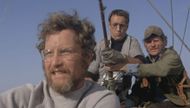
You don’t see the shark for almost an hour, and that wasn’t planned. The mechanical shark kept failing on set, and Spielberg had no choice but to work around it. He leaned on clever editing and camera angles that barely showed the creature. Floating barrels, underwater shots, and long silences did most of the work.
Instead of hurting the film, this created tension that never let up. Every shadow in the water felt like a threat. Every swell of the sea had weight. Viewers never got comfortable. The suspense stayed high because they never knew when or how the shark would appear. That fear built slowly and never left.
This move changed the film. It wasn’t just about showing the monster—it became about dreading it. The fear wasn’t in the attack. It was in the wait. That’s why this shark stayed with people long after they left the theater.
2. The Human Characters Actually Matter
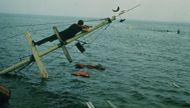
Brody isn’t a superhero. He’s a man with a fear of water and a job he can’t escape. Hooper brings knowledge, but also youth and nervous energy. Quint walks in like he’s already lived three lifetimes and carries scars that go beyond the physical.
Each character serves a clear role and has a real purpose. Brody's fear grounds the film. Hooper's expertise explains the threat. Quint's obsession fuels the third act. They clash and connect in ways that feel honest. They’re not just here to fill scenes between shark attacks. They drive the story forward and keep it human.
The audience doesn’t just want them to win—they want them to survive. That connection makes the danger real. When things go bad, it matters. You feel the risk in every moment because the film made you care. That’s why the final act hits so hard. The people fighting matter just as much as the shark.
3. The USS Indianapolis Monologue Is Pure Legend
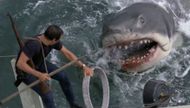
The moment isn’t loud. It doesn’t need music or flashing lights. It’s just Quint telling a story. He sits in a boat and talks about floating in shark-filled waters after the USS Indianapolis sank. He saw men pulled under and never come back up.
This scene rewrote the character. Until then, Quint was tough and closed-off. But now he had reason. His fear wasn’t abstract. It came from watching friends die slowly. The monologue added weight to his obsession. He didn’t just hunt sharks. He hated them for what they took from him.
The impact of that story is lasting. It turned the shark into more than just a creature. It became personal. It gave the film its emotional core. The scene added history to the horror and pain to the pursuit. No other shark movie has a moment like this. And that’s why no other shark movie compares.
4. John Williams’ Score Does Half the Work
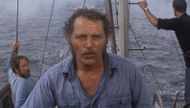
The shark doesn’t always need to appear. Sometimes it just needs to be heard. Two notes start slow and steady. They get faster and louder. That’s how John Williams built the most terrifying sound in film history. The score wasn’t just music. It became the shark.
Spielberg used the music to create presence. If the shark didn’t show up, the sound did. That kept tension high even when nothing happened. Viewers learned to expect violence with every note. It worked like a trigger. The second it started, fear took over.
The music did more than fill space. It shaped scenes. It carried dread across the water and into the theater. Williams’ theme didn’t just stay in the film. It followed people home. It kept them out of the water. It left a sound behind that still means danger. That score didn’t support the story. It helped define it.
5. It Invented the Summer Blockbuster the Right Way
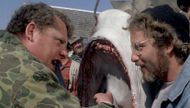
When Jaws came out, summer wasn’t for major films. Studios saved their big titles for winter. But Universal took a chance. They released it in June on over 400 screens and backed it with nonstop television ads. It was risky but it worked.
The movie didn’t rely on its marketing alone. It had a simple idea that hit hard. A shark attacks a beach town and three men go after it. That’s all it needed. The characters felt real. The tension kept building. The story never lost focus. It didn’t need a franchise to succeed.
Jaws changed the business model. It proved that people would go to theaters in the summer for something that worked. It also proved that hype wasn’t enough—you still had to deliver. And Spielberg did. That’s why every big summer movie since has tried to copy it. They all chase what Jaws pulled off first.
6. Real Ocean, Real Problems, Real Payoff
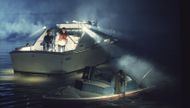
Spielberg could have used a tank. It would have saved money and time. Instead, he shot at the Atlantic Ocean. That choice turned the production into a mess. The weather ruined the takes. The shark broke constantly. At one point, the boat started to sink with actors onboard.
But all that trouble paid off. You can feel the water move. You can see the way sunlight bounces off real waves. The film doesn’t look staged because it wasn’t. That realism gave the film weight. You don’t just watch the characters float—you feel like you’re there with them.
The danger feels closer because everything looks and sounds real. You see boats shake. You hear the wind howl. The shark isn’t in a safe pool. It’s in open water. And so are the characters. That gamble cost time and money, but it gave the movie its edge. That’s what made it unforgettable.
7. The Ending Still Hits Like a Punch to the Gut
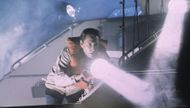
Brody has nothing left. The boat is sinking. Hooper is missing. Quint is gone. He climbs to the top of the mast, grabs a rifle, and takes aim at the air tank lodged in the shark’s mouth. He fires. It explodes. The shark dies.
This ending wasn’t in the book. Spielberg pushed for it because he wanted a moment that hit hard. Brody doesn’t win with strength. He wins with timing and nerve. He faces his fear of the ocean and survives. That matters more than just killing the shark.
Everything leads to this moment. The barrels. The chase. The tension. It all builds to one final shot. The scene doesn’t rely on tricks. It earns a reaction. When the shark blows up, it’s not just a win—it’s a relief. It lands because the film was built carefully. That last second defines the movie. And it’s still talked about fifty years later.
Follow for more updates.
Love movies? Try our Box Office Game and Movie Grid Game to test your film knowledge and have some fun!
